
Artemisia is a large, diverse genus of plants belonging to the daisy family Asteraceae, with almost 500 species. Common names for various species in the genus include mugwort, wormwood, and sagebrush.

Artemisia vulgaris, the common mugwort, is a species of flowering plant in the daisy family Asteraceae. It is one of several species in the genus Artemisia commonly known as mugwort, although Artemisia vulgaris is the species most often called mugwort. It is also occasionally known as riverside wormwood, felon herb, chrysanthemum weed, wild wormwood, old Uncle Henry, sailor's tobacco, naughty man, old man, or St. John's plant. Mugworts have been used medicinally and as culinary herbs.

Artemisia Lomi or Artemisia Gentileschi was an Italian Baroque painter. Gentileschi is considered among the most accomplished 17th-century artists, initially working in the style of Caravaggio. She was producing professional work by the age of 15. In an era when women had few opportunities to pursue artistic training or work as professional artists, Gentileschi was the first woman to become a member of the Accademia di Arte del Disegno in Florence and she had an international clientele.

The tawny speckled pug is a moth of the family Geometridae.

Artemisia abrotanum, the southernwood, lad's love, or southern wormwood, is a species of flowering plant in the sunflower family. It is native to Eurasia and Africa but naturalized in scattered locations in North America. Other common names include: old man, boy's love, oldman wormwood, lover's plant, appleringie, garderobe, Our Lord's wood, maid's ruin, garden sagebrush, European sage, sitherwood and lemon plant.
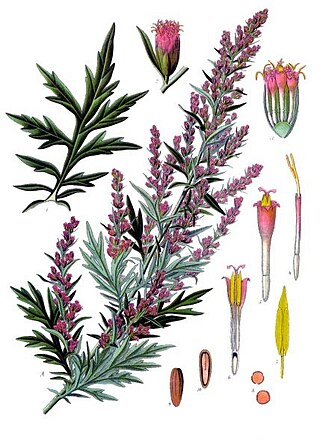
Mugwort is a common name for several species of aromatic flowering plants in the genus Artemisia. In Europe, mugwort most often refers to the species Artemisia vulgaris, or common mugwort. In East Asia the species Artemisia argyi is often called "Chinese mugwort" in the context of traditional Chinese medicine, Ngai Chou in Cantonese or àicǎo (艾草) in Mandarin. Artemisia princeps is a mugwort known in Korea as ssuk (쑥) and in Japan as yomogi (ヨモギ). While other species are sometimes referred to by more specific common names, they may be called simply "mugwort" in many contexts.

Loxostege sticticalis is a species of moth of the family Crambidae. It was first described by Carl Linnaeus in 1761 and is found in the Palearctic and Nearctic realms.

Eucarta virgo, the silvery gem, is a moth of the family Noctuidae. The species first described by Georg Friedrich Treitschke in 1835. It can be found in south, southeast and central Europe.

Schinia nuchalis, the spotted sage moth, is a moth of the family Noctuidae.

Schinia scutosa, the spotted clover, is a moth of the family Noctuidae. It is found from Europe to southern Siberia, the Near East and the Middle East and from central Asia to Japan. In North Africa it is found from Morocco to Egypt.
Cucullia santonici is a moth of the family Noctuidae. It was traditionally found from southern Europe through parts of Near East and Middle East to China.
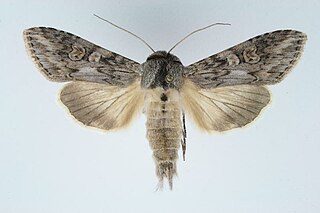
Cucullia artemisiae, or scarce wormwood, is a moth of the family Noctuidae. The species was first described by Johann Siegfried Hufnagel in 1766. It is found from central and southern Europe to Turkey and across the Palearctic to western Siberia, Central Asia, Manchuria, the Korean Peninsula and Japan.

Hellinsia lienigianus is a moth of the family Pterophoridae which inhabits coastal areas, dry pastures and waste ground and is found in Africa, Asia, Australia and Europe. Also known as the mugwort plume it was first described by Philipp Christoph Zeller in 1852.

Hellinsia distinctus is a moth of the family Pterophoridae that is found from Europe to India, Korea, Japan, China and Russia. Within Europe, it is found from Germany and the Benelux east to Poland, Slovakia, Hungary and Romania, from Italy north to Fennoscandia, and in Greece, Estonia, Latvia and northern and central Russia.
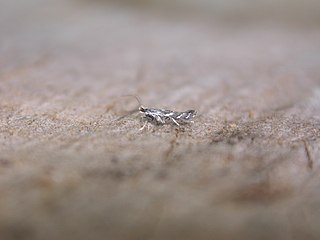
Leucospilapteryx omissella is a moth of the family Gracillariidae. It is known from all of Europe, east through Russia to Japan.

Coleophora albicans is a moth of the family Coleophoridae. It is found from Fennoscandia to the Iberian Peninsula, Italy and Bulgaria and from Great Britain to southern Russia and further east to Japan. It is also known from China.
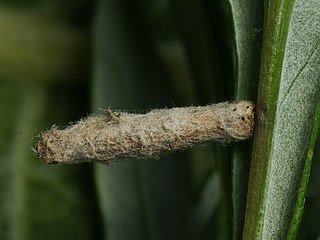
Coleophora succursella is a moth of the family Coleophoridae. It is found from Fennoscandia to the Pyrenees and Italy and from France to Poland and Slovakia.
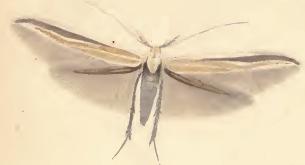
Coleophora ditella is a moth of the family Coleophoridae. It is found from Germany to the Iberian Peninsula, Italy and Bulgaria.
Scrobipalpula psilella is a moth of the family Gelechiidae. It is widely distributed throughout the Palaearctic region. It has also been recorded from North America.
















